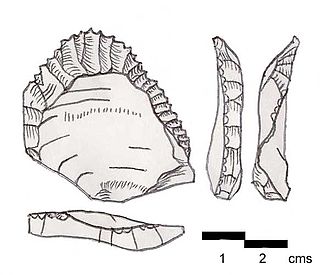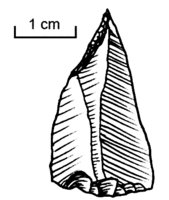
The Epipalaeolithic Near East designates the Epipalaeolithic in the prehistory of the Near East. It is the period after the Upper Palaeolithic and before the Neolithic, between approximately 20,000 and 10,000 years Before Present (BP). The people of the Epipalaeolithic were nomadic hunter-gatherers who generally lived in small, seasonal camps rather than permanent villages. They made sophisticated stone tools using microliths—small, finely-produced blades that were hafted in wooden implements. These are the primary artifacts by which archaeologists recognise and classify Epipalaeolithic sites.

The Southern Levant is a geographical region encompassing the southern half of the Levant. It corresponds approximately to modern-day Israel, Palestine, and Jordan; some definitions also include southern Lebanon, southern Syria and/or the Sinai Peninsula. As a strictly geographical description, it is sometimes used by archaeologists and historians to avoid the religious and political connotations of other names for the area.

The Aurignacian is an archaeological industry of the Upper Paleolithic associated with Early European modern humans (EEMH) lasting from 43,000 to 26,000 years ago. The Upper Paleolithic developed in Europe some time after the Levant, where the Emiran period and the Ahmarian period form the first periods of the Upper Paleolithic, corresponding to the first stages of the expansion of Homo sapiens out of Africa. They then migrated to Europe and created the first European culture of modern humans, the Aurignacian.
The Châtelperronian is a proposed industry of the Upper Palaeolithic, the existence of which is debated. It represents both the only Upper Palaeolithic industry made by Neanderthals and the earliest Upper Palaeolithic industry in central and southwestern France, as well as in northern Spain. It derives its name from Châtelperron, the French village closest to the type site, the cave La Grotte des Fées.

The Upper Paleolithic is the third and last subdivision of the Paleolithic or Old Stone Age. Very broadly, it dates to between 50,000 and 12,000 years ago, according to some theories coinciding with the appearance of behavioral modernity in early modern humans, until the advent of the Neolithic Revolution and agriculture.

The Kebaran culture, also known as the 'Early Near East Epipalaeolithic', is an archaeological culture of the Eastern Mediterranean dating to c. 23,000 to 15,000 Before Present. Its type site is Kebara Cave, south of Haifa. The Kebaran was produced by a highly mobile nomadic population, composed of hunters and gatherers in the Levant and Sinai areas who used microlithic tools.
The prehistory of the Levant includes the various cultural changes that occurred, as revealed by archaeological evidence, prior to recorded traditions in the area of the Levant. Archaeological evidence suggests that Homo sapiens and other hominid species originated in Africa and that one of the routes taken to colonize Eurasia was through the Sinai Peninsula desert and the Levant, which means that this is one of the most occupied locations in the history of the Earth. Not only have many cultures and traditions of humans lived here, but also many species of the genus Homo. In addition, this region is one of the centers for the development of agriculture.

The Jabroudian culture is a cultural phase of the Middle Paleolithic of the Levant. It broadly belongs to the Mousterian culture, and shows connections with the European facies La Quina.
Paleolithic Europe, or Old Stone Age Europe, encompasses the Paleolithic or Old Stone Age in Europe from the arrival of the first archaic humans, about 1.4 million years ago until the beginning of the Mesolithic around 10,000 years ago. This period thus covers over 99% of the total human presence on the European continent. The early arrival and disappearance of Homo erectus and Homo heidelbergensis, the appearance, complete evolution and eventual demise of Homo neanderthalensis and the immigration and successful settlement of Homo sapiens all have taken place during the European Paleolithic.

Aadloun, Adloun or Adlun is a coastal town in South Lebanon, 17 kilometres (11 mi) south of Sidon famous for its cultivation of watermelons. It is also the site of a Phoenician necropolis and prehistoric caves where four archaeological sites have been discovered and dated to the Stone Age. The evidence of human occupation of Abri Zumoffen has been dated as far back as 71,000 BCE with occupation of Bezez Cave dating back even further into the earlier Middle Paleolithic.

Ksar Akil is an archeological site 10 km (6.2 mi) northeast of Beirut in Lebanon. It is located about 800 m (2,600 ft) west of Antelias spring on the north bank of the northern tributary of the Wadi Antelias. It is a large rock shelter below a steep limestone cliff.
The Acheulo-Yabrudian complex is a complex of archaeological cultures in the Levant at the end of the Lower Palaeolithic. It follows the Acheulian and precedes the Mousterian. It is also called the Mugharan Tradition or the Acheulo-Yabrudian Cultural Complex (AYCC).

Archaeology of Lebanon includes thousands of years of history ranging from Lower Palaeolithic, Phoenician, Roman, Arab, Ottoman, and Crusades periods.
The Sands of Beirut were a series of archaeological sites located on the coastline south of Beirut in Lebanon.
Antelias Cave was a large cave located 2.5 km (1.6 mi) east of Antelias, 10 km (6.2 mi) northeast of Beirut close to the wadi of Ksar Akil.

Southwest Asian Neanderthals were Neanderthals who lived in Turkey, Lebanon, Syria, Israel, Palestine, Iraq, and Iran - the southernmost expanse of the known Neanderthal range. Although their arrival in Asia is not well-dated, early Neanderthals occupied the region apparently until about 100,000 years ago. At this time, Homo sapiens immigrants seem to have replaced them in one of the first anatomically-modern expansions out of Africa. In their turn, starting around 80,000 years ago, Neanderthals seem to have returned and replaced Homo sapiens in Southwest Asia. They inhabited the region until about 55,000 years ago.
The Ahmarian culture was a Paleolithic archeological industry in the Levant dated at 46,000–42,000 years before present (BP) and thought to be related to Levantine Emiran and younger European Aurignacian cultures.

The Levantine Aurignacian is an Upper Paleolithic culture of the Near-Eastern Levant that evolved from the Emiran culture. It was named so because of the similarity of stone tools with the Aurignacian culture in Europe. The Levantine Aurignacian used to be called Lower and Upper Antelian in old sources, from the site of Wadi Antelias in Lebanon. The most important innovation in this period is the incorporation of some typical elements of Aurignacian, like some types of burins and narrow blade points that resemble the European type of Font-Yves.

Anna Belfer-Cohen is an Israeli archaeologist and paleoanthropologist and Professor Emeritus at the Institute of Archaeology, The Hebrew University of Jerusalem. Belfer-Cohen excavated and studied many important prehistoric sites in Israel including Hayonim and Kebara Caves and open-air sites such as Nahal Ein Gev I and Nahal Neqarot. She has also worked for many years in the Republic of Georgia, where she made important contributions to the study of the Paleolithic sequence of the Caucasus following her work at the cave sites of Dzoudzuana, Kotias and Satsrublia. She is a specialist in biological Anthropology, prehistoric art, lithic technology, the Upper Paleolithic and modern humans, the Natufian-Neolithic interface and the transition to village life.

Fumane Cave is a dolomite cave in the Fumane Valley, which was formed in the Neogene period. The cave contains rich evidence of three prehistoric hominid cultures: Mousterian, Uluzzian and Aurignacian. Additionally, the cave has some of the oldest cave art that has been discovered in Europe.
















